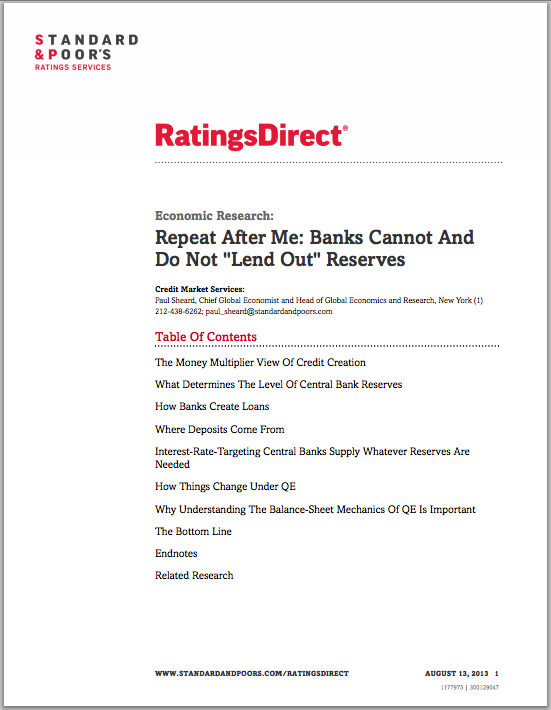Standard & Poor’s Explain Money Creation: “Banks can not and do not ‘lend out’ reserves”


This is a must-read report by Standards & Poor’s, the world’s leading credit rating agency. The title is clear: “Repeat after me: Banks can not and do not “lend out” reserves”. In this economic research they debunk the myths that we’ve written extensively about on our website, in the books Where does money come from? and Modernising Money and explained in our video course Banking 101:
The Money Multiplier View of Credit Creation
What Determines the Level of Central Bank Reserves
How Banks Create Loans
Where Deposits Come From
and more
From the report:
“Banks lend by simultaneously creating a loan asset and a deposit liability on their balance sheet. That is why it is called credit “creation” – credit is created literally out of thin air (or with the stroke of a keyboard).”
John Maynard Keynes famously wrote that:
“Practical men, who believe themselves to be quite exempt from any intellectual influence, are usually the slaves of some defunct economist.”
“A modern example of that dictum, relevant to the economy, policy, and markets, is the widespread view that banks can “lend out” their reserves (deposits) at the central bank, as if bank reserves represented a pool of money that is just waiting to “flow into” bank lending. Because such a thing cannot occur and therefore has not occurred, the point is usually made in reverse: banks currently are not “lending out” their reserves–rather they are “parking” their reserves at the central bank or leaving them “idle.”
• Many talk as if banks can “lend out” their reserves, raising concerns that massive excess reserves created by QE could fuel runaway credit creation and inflation in the future. But banks cannot lend their reserves directly to commercial borrowers, so this concern is misplaced.
• Banks do need to hold reserves (as a liquidity buffer) against their deposits, and banks create deposits when they lend. But normally banks are not reserve constrained, so excess reserves do not loosen a reserve constraint.
• Banks in aggregate can reduce their reserves only to the extent that they initiate new lending and the bank deposits created as a result flow into the economy as new banknotes as the public demands more of them.
• QE does aim to ease financial conditions and spur more bank lending than otherwise would have occurred, but the mechanisms by which this happens are much more subtle and indirect than commonly implied.
• If the excess reserves created by QE were to be associated with too much credit creation, central banks could readily extinguish them.